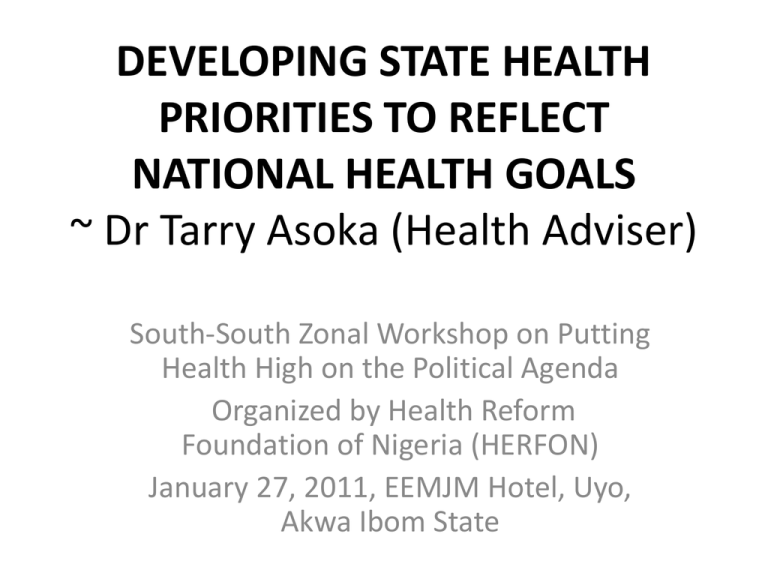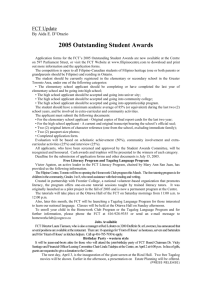developing_state_hea..
advertisement

DEVELOPING STATE HEALTH PRIORITIES TO REFLECT NATIONAL HEALTH GOALS ~ Dr Tarry Asoka (Health Adviser) South-South Zonal Workshop on Putting Health High on the Political Agenda Organized by Health Reform Foundation of Nigeria (HERFON) January 27, 2011, EEMJM Hotel, Uyo, Akwa Ibom State Introduction • Political Economy – Nigeria is a ‘federal country’; 36 States, Federal Capital Territory (FCT), 774 LGAs • States have considerable resources and autonomy (revenues > annual budgets of countries in SSA) • Federal Government, all States, FCT and all LGAs – have collective responsibility for health care to the entire population • But lack of cooperation among 3 tiers – acting against effective and efficient delivery of health care in the country. Institutional Context • State and Local governments - protective of their independence in decision making • They tend to favour large, visible, and capital intensive projects • Federal Ministry of Health & its Agencies - largely influenced by a desire to retain control over the flow of funds from the national budget, & political and financial opportunities that these provide • Situation compounded by lack of coordination of policies; characterised by parallel implementation systems, which result in duplication of service delivery interventions and overlap even within each tier. But things are looking different There is now a national framework for coordinated actions towards achieving the national health objectives: • composite National Strategic Health Development Plan (NSHDP) 2010 – 2015 • drawn from the individual strategic health plans of the 36 States, the Federal Capital Territory (FCT) • the NSHDP represents Nigeria’s One National Health Plan, with One Results Framework, and One Monitoring and Evaluation (M&E) System Mutual Accountability by all Stakeholders • Signing of the declaration of this plan by all the 36 State Governors and FCT Minister • All States & FCT - agree to be individually and collectively held responsible and accountable for achievement of outcomes as outlined in the National Results Framework • President & Minister of Health - signed the Nigeria Country Compact with International Development Partners • NSHDP now considered a ‘social compact’ between political leadership (irrespective of party affiliation) and the citizens of the respective States. How Important is this? You need to be aware of this arrangement (the NSHDP) because your performance in the health sector will be assessed on the basis of how well you have met the targets in your State, as stated in the National Results Framework. NSHDP (2010 – 2015): Situation Nigeria’s health system performance ranked 187th out of 191 member States by WHO in 2000 PHC - bedrock of the national health system, remains prostrate due to gross under funding, mismanagement & lack of capacity at LGA level Poor Health Indicators - immunization coverage of 23%; 6% of under-fives sleeping under ITNs; only a third of children with fever appropriately treated at home; at less than half of deliveries attended to by skilled health personnel Wide regional variations – Zones, States, Rural/Urban NSHDP (2010 – 2015): Response • Given that recent improvement in Nigeria’s macroeconomic performance not translated into discernable improvement in the quality of life of Nigerians; • And given that, to meet challenges of achieving improved health status particularly for its poorest & most vulnerable population, the health system must be strengthened; • The Federal Ministry of Health (FMOH) understands that this can best be done within the context of a costed National Strategic Health Development Plan (NSHDP) NSHDP (2010 – 2015): Process • Generic Framework developed to serve as guide to Federal, States & LGAs in the selection of evidenced-based priority interventions • Major steps in development of NSHDP Framework included: conduct of 10 background studies; inauguration of a steering committee and technical working group comprising all stakeholders • Using NSHDP Framework costed Federal & State Strategic Health Plans were developed • Federal level, 36 States & FCT health plans were then collated and harmonized into the one NSHDP The National Health Plan Vision: To reduce the morbidity and mortality rates due to communicable diseases to the barest minimum; reverse the increasing prevalence of non-communicable diseases; meet global targets on the elimination and eradication of diseases; and significantly increase the life expectancy and quality of life of Nigerians Mission Statement: To develop and implement appropriate policies and programmes as well as undertake other necessary actions that will strengthen the National Health System to be able to deliver effective, quality and affordable health The overarching goal of the NSHDP: To significantly improve the health status of Nigerians through the development of a strengthened and sustainable health care delivery system Key Issues to be addressed by NSHDP Weakness of government’s provision of primary health care services Organization and management difficulties that affect the entire health system Lack of clarity in the division of responsibilities across different levels of government Weak linkages across the different levels of government and stakeholders Inadequate governance and accountability at all levels of the health system Opportunity offered by a dynamic private sector that can fill part of the gap left by the weak PHC system Priorities for Revitalized National Health System Focus on two broad agenda: 1. Delivery of an essential package of care – available and accessible to all Nigerians 2. Improving the performance of the health system – through a holistic approach at Federal, State and LGA levels targeted at 8 evidenced-based priority areas: leadership and governance, service delivery, human resources for health, health financing, health information system, community participation and ownership, partnerships for health, and research for health Essential Package of Care (A)Family & Community Oriented Services - Insecticide Treated Mosquito Nets for children under 5 and pregnant women; Access to improved water source, Infant & Young Child Feeding etc (B) Population Oriented / Outreach Services - Immunisation; Ante-natal care, Family Planning etc (C) Individual / Clinical Oriented Services - Artemisinin-based Combination Therapy for children, Normal delivery by skilled attendant & Emergency Obstetric Care, etc 8 Priority Areas (1) LEADERSHIP & GOVERNANCE - Streamline & empower Ministries of Health at the Federal & State levels + LGA Health Departments - Reposition their organisational & management systems to provide strategic & tactical leadership - Enhance mutual accountability & transparency in the use of health development resources (2) HEALTH SERVICE DELIVERY - Deliver the essential package of care to all - Improve the functionality, quality of care and utilization of services Priority Areas II (3) HUMAN RESOURCES FOR HEALTH - Get the right number of health personnel, in the right place, doing the right job, at the right pay and motivated to stay on based on the right incentives (4) HEALTH FINANCING - Increase budgetary allocation to meet the needs of the health system - Provide financial risk protection, especially for the poor & vulnerable through social health insurance, vouchers, and exemptions etc. Priority Areas III (5) NATIONAL HEALTH INFORMATION SYSTEM - Provide resources: materials, money and men (women) to obtain information for planning and monitoring progress (6) COMMUNITY PARTICIPATION & OWNERSHIP - Engage communities in needs identification, planning and implementation of health programmes - Empower citizens to undertake actions to improve their health situations Priority Area IV (7) PARTNERSHIP FOR HEALTH - Partner with the private sector, non-governmental organisations, communities and development partners (donors) as well as other social and economic sectors to deliver health services (8) RESEARCH FOR HEALTH - Use simple methods to get some information to know how well health programmes are being received by the people Progress so far – 2010 NSHDP Joint Annual Review Global awareness of the existence of the NSHDP, but poor understanding of it works Data for 2010 on key health outcome indictors based on national results framework not available Progress on health system performance is variable Main recommendations 1. Government at all levels to concentrate efforts on delivering essential package of care 2. rapidly scale-up mechanisms to protect people from financial difficulties when accessing services NSHDP (2010 – 2015): Emerging Issues 1. The need to constantly be engaged with the political process 2. The need to strengthen the implementation capacity at the State level 3. The need to improve the monitoring and evaluation of the plan Conclusion The arena where real actions are required to turn around the dismal health indicators of the country is at the State level. And with the current zeal being shown by citizens to participate more actively in the political process, it may no longer be business as usual. In the not too distant future, citizens would be holding political office holders to account for their stewardship. But they too require some level of enlightenment that can equip them for the task ahead.











